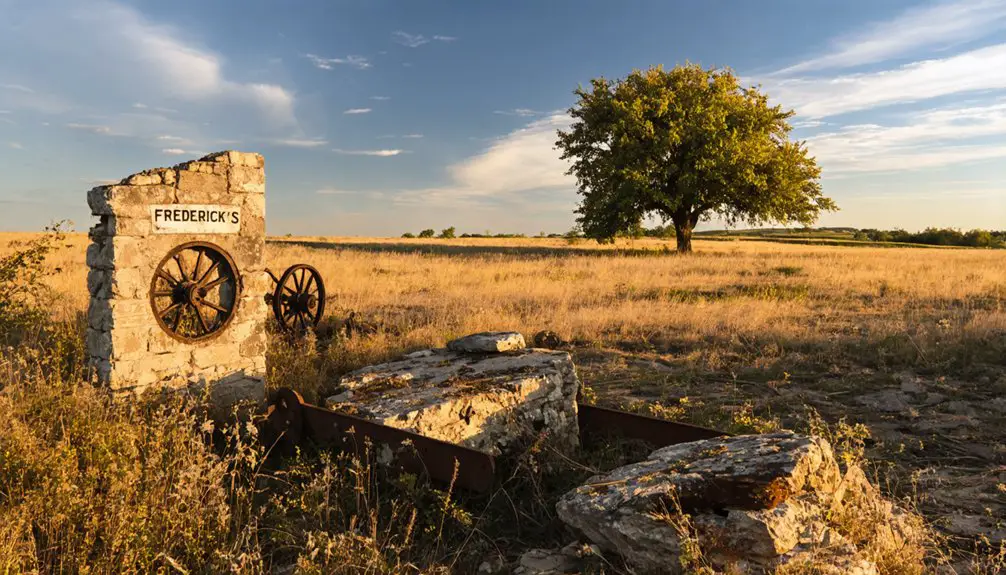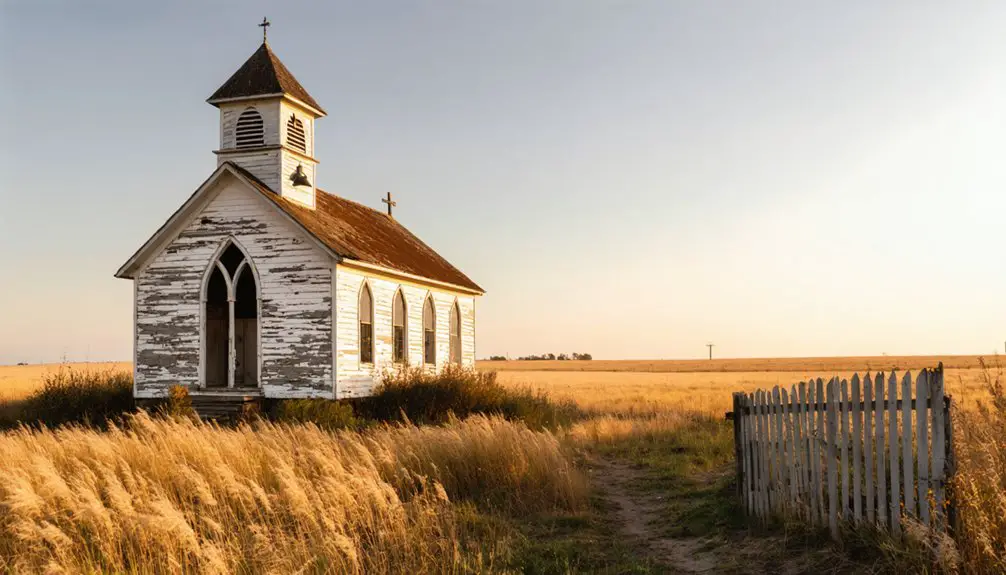If you’re interested in Kansas ghost towns, you’ll find Frederick’s story fascinating. Founded in 1878 at a railroad junction, it grew into a bustling agricultural hub of nearly 1,000 residents by the early 1900s. The town boasted three grain elevators, a flour mill, and a distinctive steel-cage jail built in 1891. Today, with just 8 residents, it’s Kansas’s smallest incorporated city, though its historic buildings and local tales preserve its remarkable past.
Key Takeaways
- Frederick, Kansas, founded in 1878 at a railroad junction, declined from a peak population of 1,000 to just 8 residents by 2020.
- The town’s decline began after its post office closure in 1954, making it Kansas’s least populated incorporated city.
- A historic jail from the early 1900s remains standing, featuring a distinctive steel cage system installed in 1891.
- The town once thrived with three grain elevators, a flour mill, grocery stores, and various businesses serving the agricultural community.
- Frederick exemplifies Kansas ghost towns’ common fate, caused by mechanized farming and changing transportation patterns.
The Rise of a Promising Plains Settlement
While many Kansas settlements emerged alongside railroad development in the late 1800s, Frederick’s founding at the junction of two major rail lines in 1878 positioned it for remarkable growth.
Railroad Influence truly transformed this Plains settlement after 1887, when the Missouri Pacific’s arrival sparked rapid expansion of commerce and population. The town’s strategic location made it a crucial agricultural hub, where you’d have seen three busy grain elevators, a flour mill, and a bustling tractor dealership serving local farmers. Much like ancient Rome’s decline, Frederick would eventually see its population plummet from its heyday as economic conditions changed. Today, the town is merely a shell of its former self with just nine to ten residents remaining.
Agricultural Growth defined Frederick’s early promise, as the town supported nearly 1,000 residents at its peak. With churches, schools, a three-story hotel, and essential services like telegraph and telephone offices, Frederick embodied the spirit of ambitious frontier development.
Life in Frederick’s Golden Era
During Frederick’s golden era, you’d have found a vibrant community of roughly 150 residents living amid a bustling local economy. The town hummed with local industries including multiple grocery stores, a busy lumberyard, and blacksmith shops serving daily needs. Today, with only 8 residents remaining, Frederick stands as Kansas’s least populated incorporated city. Like many Kansas settlements, the town experienced a sharp decline when natural disasters struck the region.
Community gatherings centered around churches and schools, while restaurants provided places for neighbors to connect and share news.
Local churches, schools and eateries formed the heart of Frederick’s social fabric, where townsfolk gathered to strengthen community ties.
- A railroad junction kept trade flowing and employment steady
- Banks and a telephone office supported growing business activity
- Family-owned shops lined the main streets, fostering independence
You could’ve conducted all your essential business right in town, from banking to buying lumber for your homestead.
The strong bonds between residents, many with deep generational roots, created a self-reliant plains community that exemplified the freedom-loving spirit of rural Kansas.
The Historic Frederick Jail’s Legacy
Standing as one of Frederick’s few remaining structures, the early 1900s jail tells a stark story of law and order in small-town Kansas.
You’ll find this concrete fortress with its distinctive jail architecture – a steel cage nestled within its walls – remarkably preserved despite decades of abandonment. In 1891, the original wooden cells were replaced with a steel cage system designed to prevent escapes.
Local folklore remembers it by various nicknames: calaboose, hoosegow, or bastille.
Inside, prisoners faced harsh conditions, enduring extreme temperatures with only wool blankets for comfort. During the War of 1812, the facility served as a mustering point for local militia.
The facility primarily housed those arrested for drunkenness, petty theft, and disturbing the peace, eventually becoming little more than a “drunk tank” by mid-century.
Today, alongside the empty schoolhouse and abandoned playground, this well-preserved jail stands as a haunting reminder of Frederick’s faded glory, drawing historians and photographers curious about its austere past.
From Bustling Town to Near Abandonment
You’ll find it hard to believe that Frederick once bustled with nearly 1,000 residents during its peak as a thriving agricultural and railroad hub in the early 1900s.
The town’s vibrant economy supported three grocery stores, multiple businesses, and professional services, including doctors, dentists, and a three-story hotel that temporarily served as a county seat. Like many Kansas settlements, Frederick emerged during the era when Euro-American squatters began claiming Native American lands in the 1850s. Similar to the remnants found in Bainville shipping point, there are few visible traces of Frederick’s former significance.
Today, you can witness the stark reality of Frederick’s near abandonment, with just a handful of occupied houses remaining and roughly 80% of its peak population lost over the past century.
Population Peak to Decline
As Frederick emerged as a vital railroad junction in 1909, the town quickly transformed into Rice County’s bustling commercial hub, boasting essential amenities from multiple banks and grocery stores to a thriving flour mill and three grain elevators.
The population statistics paint a stark picture of change – from a peak of around 150 residents during its heyday to just 8 people by 2020, making it Kansas’s least populated city. To avoid confusion with other similarly named locations, Frederick, Kansas required clear disambiguation entries in historical records and databases. Like many of Kansas’s dead prairie towns, Frederick’s decline mirrored the state’s documented loss of over 6000 communities.
- A thriving community with local government, brass band, and fraternal groups dwindled to near-ghost town status
- The closure of the post office in 1954 marked a turning point in the town’s demographic decline
- By 2015, only 9-10 residents remained, with most businesses and municipal functions having disappeared
This dramatic transformation left Frederick struggling to maintain its incorporation status through multiple contested votes and governance challenges.
Economic Hub Vanishes
Once a vibrant economic powerhouse in Rice County, Frederick’s transformation from bustling hub to near-ghost town tells a sobering story of small-town decline.
You would’ve found a thriving commercial district in the early 1900s, where grain elevators, flour mills, and lumberyards served a population of 1,000. The town’s economic transformation hinged on its strategic location at the junction of two major railroads.
But by 2015, you’d find no trace of the businesses that once defined Frederick’s community resilience. The post office closed in 1954, and one by one, the grocery stores, blacksmiths, and automobile dealerships vanished.
Mechanized farming and changing transportation patterns stripped away the town’s economic foundation, leaving behind empty lots where commercial buildings once stood.
Surviving Remnants and Local Memory

The surviving remnants of Frederick, Kansas paint a sparse portrait of what was once a functioning small town. You’ll find scattered homes and deteriorating structures that tell the story of local heritage through their weathered walls.
While the post office closed in 1954, community stories live on through the approximately 18 residents who maintain Frederick’s incorporated status, making it Kansas’s smallest incorporated town.
- Original buildings stand as silent witnesses to the town’s change from urban to agricultural land
- Local oral histories preserve memories of Frederick’s role in regional development
- Post office records from 1887-1954 document the town’s operational timeline
Though formal preservation efforts are minimal, Frederick’s legacy endures through regional consciousness and the determination of its remaining inhabitants to maintain their unique place in Kansas history.
Kansas Ghost Towns: A Broader Perspective
Frederick’s story mirrors thousands of similar communities across Kansas, where ghost towns dot the landscape at remarkable intervals – approximately one defunct settlement every 12 miles.
You’ll find over 6,000 “dead” towns identified by the Kansas Historical Society, though only 308 make the official ghost town listings. These settlement patterns reflect the dramatic cycles of Kansas history, from railroad boom times to Dust Bowl devastation.
Like Frederick, many towns peaked in population during the late 1800s before succumbing to familiar ghost town characteristics: bypassed by changing transportation routes, losing county seat battles, or falling victim to economic busts.
Today, you’ll discover their remnants through scattered cemeteries, crumbling foundations, and historical records, each telling a unique story of western expansion and rural transformation.
Frequently Asked Questions
What Natural Disasters or Major Events Contributed to Frederick’s Decline?
Like a slowly dimming lantern, you’ll find Frederick’s story wasn’t shaped by one disaster, but by drought impact and railroad decline combining with broader economic shifts that gradually emptied the town’s streets.
Are There Any Paranormal Stories Associated With the Frederick Jail?
You won’t find documented ghostly encounters at Frederick Jail – despite its early 1900s jail history, there aren’t any verified paranormal stories or supernatural claims associated with this simple concrete calaboose.
What Happened to the Proposed Wildhorse Lake Resort Project?
You’ll find that Wildhorse Lake resort plans never materialized due to complex regulatory hurdles, funding challenges, and water rights issues. The proposed development joined many abandoned projects in Southeast Kansas.
Do Any Original Business Ledgers or Town Records Still Exist?
You won’t find direct evidence of surviving business ledgers today. While record preservation efforts exist in Kansas historical archives, no original town records from Frederick’s heyday have been conclusively documented.
Can Visitors Legally Explore the Remaining Structures in Frederick Today?
You can’t legally explore Frederick’s structures without property owner permission, as ghost town regulations prohibit trespassing. For visitor safety and liability reasons, unauthorized entry into private buildings remains forbidden.
References
- http://kansasghosttowns.blogspot.com/2015/07/frederick-population-nine-lingers-as.html
- https://www.instagram.com/reel/DMkrHH0t5rz/
- https://legendsofkansas.com/kansas-ghost-town-list/
- http://kansasghosttowns.blogspot.com
- https://abandonedks.com/frederick-jail/
- https://en.wikipedia.org/wiki/Rome
- https://octa-trails.org/wp-content/uploads/2023/05/Ellis-Uniontown-and-Plowboy–-Potawatomi-Ghost-Towns.pdf
- https://freepages.rootsweb.com/~gtusa/history/usa/ks.htm
- https://www.youtube.com/watch?v=JvCecTIBmFI
- https://legendsofkansas.com/every-place-in-kansas-c/



